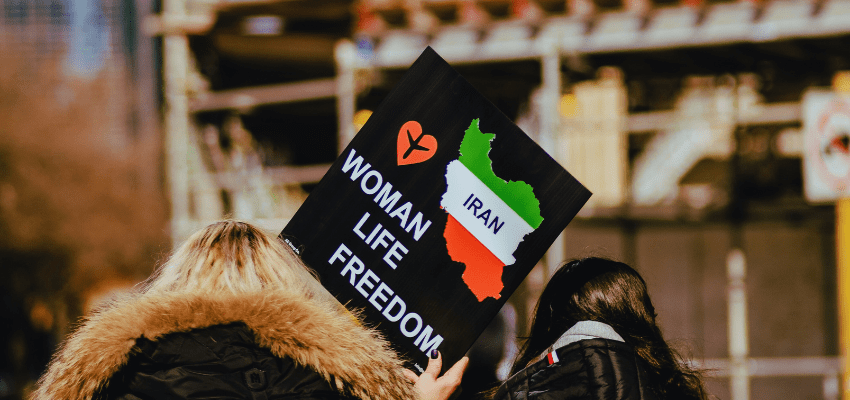This article originally appeared in Newsweek.
By Mariam Memarsadeghi, January 13, 2025
Never in history have the women of a nation suffered so profound a reversal of their rights and status as the women of Iran did in 1979. Islamists and Marxists joined together to overthrow a secular, modernizing monarchy that had made equality for women touchstone for the nation’s progress. Anti-Shah protestors may have chanted for “freedom” but they quickly gave rise to a theocratic totalitarianism whose first and forever war has been on Iranian women.
Virtually overnight, the new gender apartheid state rolled back laws and opportunities that had for decades already lifted Iranian women up from the subservience clerics demanded. The new Islamic Republic of Iran was vindication for the backward underbelly of a country that had emerged with lightning speed from traditionalism. The proudly backward were validated by self-loathing Western intellectuals, leading philosophers such as Michel Foucault who saw in the revolution a thrilling rebuke to liberal democracy when communism no longer was.
The regime imposed a medieval dress code on women (and girls from the age of nine), ejected them from the workforce, violently policed their movement and segregated them from men, stripped them of their most fundamental rights, and lashed them for sexual relations and for otherwise refusing to abide by Handmaid’s Tale restrictions on their personhood. Universities were purged of faculty who had an ounce of sympathy for liberalism and equality. The new state’s radio and television, along with revamped school textbooks, street propaganda, and very public displays of Godly devotion, fixated on the need for women to be covered, confined, and controlled.
Those who resisted were taken to the dungeons. Virgins were systematically raped before being executed. The rationale was codified in Sharia: Virgins must not be killed, so the regime decreed they must be raped first before being hung. The country’s most accomplished women were among those executed, such as Minister for Education Farrokhrou Parsa, who was put into a sack, dragged to the gallows, and shot. Entrepreneurial, liberal-minded Iranians who did survive the terror had their belongings confiscated. Millions fled their homeland.
As a child I remember feeling the color black had been poured over every bit of the country and that everyone had suddenly turned mute.
Women’s subjugation—in particular, the mass adherence to hijab—became symbolic of the Islamic Republic’s power and control. In 46 years, nothing has changed. The Supreme Leader Ali Khamenei, a student of the KGB and the Soviets’ failed attempt at Glasnost and Perestroika reforms, always presents a facade of reform, while in practice he ensures the state grows more repressive with every passing year.
After the regime’s morality police beat the young, innocent Mahsa Amini to death in 2022 for showing strands of hair beneath her hijab, the Woman Life Freedom protest movement erupted, the newest iteration of Iranian protest movements for freedom. In the 2009 Green Movement protests, if not before, Iranians were already shouting “Death to the Dictator,” but Woman Life Freedom was the most ubiquitous call yet for wholesale regime change.
The nonviolent civil disobedience tactics were diverse, the protests were strategically sequenced, every class and every geographic part of the country was mobilized. Labor strikes were secured from every sector of the economy, the diaspora sustained its solidarity with unrelenting protests across the globe, and internationally, politicians, celebrities, business leaders, intellectuals, artists, musicians, and others were outspoken in their support.
But it was not enough. As he had done in a 2019 massacre of over 1,500 peaceful protestors, Khamenei gave orders to kill. His Islamic Revolutionary Guard Corps, the same force that helped to annihilate 500,000 Syrians and 250,000 Yemenis and conspired with proxies to terrorize Israelis on October 7, had no reservation about shooting protestors in the heart and head, blinding their eyes, beating them, raping them, torturing them, executing them. Later, after the crackdown was secured, the schoolgirls who were the beating heart of the revolution were systematically poisoned.
The aspiration to be rid of a cabal that has waged war on Iranian women and destroyed the nation will never be extinguished. Any telling of modern Iranian history that does not begin with how the 1979 revolution decimated the dignity of Iranian women and girls is not rooted in truth.
Sooner or later, Iranian women will win their freedom. Everyone in the world must stand with them on the right side of history.
Mariam Memarsadeghi is Founder and Director of the Cyrus Forum, Senior Fellow at the Macdonald-Laurier Institute, and a leading advocate for a democratic Iran.







